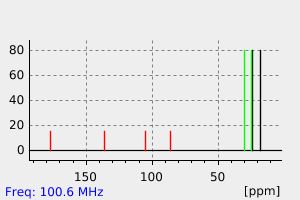6-氯-2,5-二甲基-3,4-二氢-2H-吡喃-2-甲酰氯 | 97424-78-7
中文名称
6-氯-2,5-二甲基-3,4-二氢-2H-吡喃-2-甲酰氯
中文别名
——
英文名称
6-chloro-3,4-dihydro-2,5-dimethyl-2H-pyran-2-carbonyl chloride
英文别名
6-chloro-2,5-dimethyl-3,4-dihydro-2H-pyran-2-carbonyl chloride;6-chloro-2,5-dimethyl-3,4-dihydropyran-2-carbonyl chloride
CAS
97424-78-7
化学式
C8H10Cl2O2
mdl
——
分子量
209.072
InChiKey
ASPQYZAUAABCLE-UHFFFAOYSA-N
BEILSTEIN
——
EINECS
——
-
物化性质
-
计算性质
-
ADMET
-
安全信息
-
SDS
-
制备方法与用途
-
上下游信息
-
文献信息
-
表征谱图
-
同类化合物
-
相关功能分类
-
相关结构分类
物化性质
-
沸点:258.8±40.0 °C(Predicted)
-
密度:1.28±0.1 g/cm3(Predicted)
计算性质
-
辛醇/水分配系数(LogP):2.7
-
重原子数:12
-
可旋转键数:1
-
环数:1.0
-
sp3杂化的碳原子比例:0.62
-
拓扑面积:26.3
-
氢给体数:0
-
氢受体数:2
反应信息
-
作为反应物:描述:参考文献:名称:Methacryloyl chloride dimers: from structure elucidation to a manifold of chemical transformations摘要:We report the isolation and elucidation of structure, formation mechanisms, and reactivity of elusive methacryloyl chloride dimers. Upon standing of a sample of methacryloyl chloride (1) for prolonged periods of time dimer 3 forms via oxa-Diels-Alder reaction even at low temperatures. If traces of a Lewis acid are present, dimer 3 isomerizes into a mixture of 2-oxo-cyclopentanecarbonyl chlorides 4, 14, and traces of 5, with a relative ratio that depends on the nature of the Lewis acid and reaction time. Dimer 3 can also be separated and isolated by vacuum distillation and selectively converted into derivatives of 2,5-dimethyl-2-hydroxyadipic acid, as well as into the compound 14 by treating with a catalytic amount of titanium tetrachloride. Additionally, based on the study, suggestions on purification and handling of methacryloyl chloride are proposed. (C) 2014 Elsevier Ltd. All rights reserved.DOI:10.1016/j.tet.2014.07.019
-
作为产物:描述:甲基丙烯酰氯 以 neat (no solvent) 为溶剂, 反应 1461.0h, 以50%的产率得到6-氯-2,5-二甲基-3,4-二氢-2H-吡喃-2-甲酰氯参考文献:名称:Methacryloyl chloride dimers: from structure elucidation to a manifold of chemical transformations摘要:We report the isolation and elucidation of structure, formation mechanisms, and reactivity of elusive methacryloyl chloride dimers. Upon standing of a sample of methacryloyl chloride (1) for prolonged periods of time dimer 3 forms via oxa-Diels-Alder reaction even at low temperatures. If traces of a Lewis acid are present, dimer 3 isomerizes into a mixture of 2-oxo-cyclopentanecarbonyl chlorides 4, 14, and traces of 5, with a relative ratio that depends on the nature of the Lewis acid and reaction time. Dimer 3 can also be separated and isolated by vacuum distillation and selectively converted into derivatives of 2,5-dimethyl-2-hydroxyadipic acid, as well as into the compound 14 by treating with a catalytic amount of titanium tetrachloride. Additionally, based on the study, suggestions on purification and handling of methacryloyl chloride are proposed. (C) 2014 Elsevier Ltd. All rights reserved.DOI:10.1016/j.tet.2014.07.019
文献信息
-
FISCHER, W.;BELLUS, D.;ALDER, A.;FRANCOTTE, E.;ROLOFF, A., CHIMIA, 1985, 39, N 1, 19-20作者:FISCHER, W.、BELLUS, D.、ALDER, A.、FRANCOTTE, E.、ROLOFF, A.DOI:——日期:——
表征谱图
-
氢谱1HNMR
-
质谱MS
-
碳谱13CNMR
-
红外IR
-
拉曼Raman
-
峰位数据
-
峰位匹配
-
表征信息
同类化合物
(2R)-2,6-二羟基-5-[(E)-丙-1-烯基]-1,2-二氢吡喃并[3,2-b]吡咯-3,7-二酮
黄绿青霉素
麦芽醇
麦芽酚铁
马索亚内酯
香豆酸
香豆灵酸甲酯
香叶吡喃
顺式-1-(3-呋喃基)-1,7,8,8a-四氢-5,8a-二甲基-3H-2-苯并吡喃-3-酮
靠曼酸乙酯; 4-吡喃酮-2-羧酸乙酯
靠曼酸
镭杂9蛋白质
铝3-羟基-2-甲基-4-吡喃酮
钠[(1E,7E,9E,11E)-6-羟基-1-(3-羟基-6-氧代-2,3-二氢吡喃-2-基)-5-甲基十七碳-1,7,9,11-四烯-4-基]硫酸盐
避虫酮
辛伐他汀杂质C
褐鸡蛋花素
脱氢乙酸缩氨基硫脲
脱氢乙酸
罌粟酸
维达列汀
福司曲星
福司曲星
磷内酯霉素F
磷内酯霉素E
磷内酯霉素D
磷内酯霉素A
白屈菜酸
甲基6-甲氧基-2-甲基-5-氧代四氢-2H-吡喃-2-羧酸酯
甲基6-氧杂双环[3.1.0]己烷-1-羧酸酯
甲基4-氧代-4H-吡喃-3-羧酸酯
甲基4,6-二-O-乙酰基-2,3-二脱氧己-2-烯基吡喃糖苷
甲基2H-吡喃-5-羧酸酯
甲基2-乙氧基-6-甲基-3,4-二氢-2H-吡喃-4-羧酸酯
甲基2-乙氧基-4-氧代-3,4-二氢-2H-吡喃-5-羧酸酯
甲基2-乙氧基-3-甲基-4-氧代-3,4-二氢-2H-吡喃-5-羧酸酯
甲基(4S)-2-氧代-4-[(2E)-1-氧代-2-丁烯-2-基]-3,4-二氢-2H-吡喃-5-羧酸酯
甲基(2S,5R)-5-甲氧基-3-硝基-2,5-二氢-2-呋喃羧酸酯
甲基(2S)-4-甲基-3,6-二氢-2H-吡喃-2-羧酸酯
甲基(2R)-四氢-2H-吡喃-2-羧酸酯
环庚三烯并[b]吡喃-2(5H)-酮,9-(3-丁烯基)-3-(环丙基苯基甲基)-6,7,8,9-四氢-4-羟基-
环吡酮杂质B
焦袂康酸O-甲基醚
沉香四醇
氨甲酸,[3-[(苯基甲基)氨基]三环[3.3.1.13,7]癸-1-基]-,1,1-二甲基乙基酯(9CI)
毛子草酮
棒曲霉素-13C3
棒曲霉素
木菌素
木糖酸二钠盐







